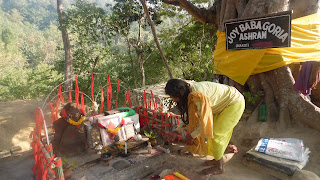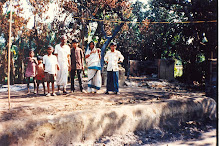Unakoti,
Tripura, India: Ten Million Reasons why Lord Shiva’s Rest Area could be Ours
Too
Sachi
G. Dastidar
India is a land of
ancient culture and tradition with thousands and thousands of holy and
archeological sites: some well-known and others hardly known but great
treasures worth visiting nonetheless. Unakoti in northeast Tripura state of
northeast India is such a remarkable place yet rarely visited by anyone.
According to Tripura Government literature
Unakoti “…is ‘Shaiba’ (Saivite) pilgrimage and dates back to 7th – 9th
centuries if not earlier. The marvelous rock carvings, murals with their
primitive beauty, waterfalls are not to be missed. Unakoti means one less than
a crore [ten million] and it is said that these many rock cut carvings are
available here. As per Hindu mythology, when Lord Shiva was going to Kashi [Varanasi]
along with one crore gods and goddesses He made a night halt at this location.
He asked all the gods and goddesses to wake up before sun rise and proceed for Kashi.
“It is said that in the morning,
except Shiva himself, no one else could get up so Lord Shiva set out for Kashi
Himself cursing others who become stone images. As a result we have one less
than a crore [ten million] stone images and carvings at Unakoti. These carvings
are located at a beautifully landscaped forest area with green vegetation all
around which add to the beauty of the carvings. The images found at Unakoti are
of two types, namely rock-carved figures and stone images.
“Among the rock cut carvings, the
central Shiva head and gigantic Ganesha figures deserve special mention. The
central Shiva head known as ‘Unakotiswara Kal Bhairava’ is about 30 feet high
including an embroidered head-dress which itself is 10 feet high. On each side
of the head-dress of the central Shiva, there are two full size female figures
- one of Durga standing on a lion and another female figure on the other side.
In addition three enormous images of Nandi Bull are found half buried in the
ground. There are various other stone as well as rock cut images at Unakoti.
Every year a big fair popularly known as ‘Ashokastami Mela’ is held in the
month of April which is visited by thousands of pilgrims.” (Tripura Tourism
Department web site)
Best way to reach Unakoti
is by road from the state capital Agartala. Agartala is connected by air with
Kolkara (Calcutta), Delhi and Guwahati. The 180 kilometer meandering road
journey takes about four hours as the road passes through congested areas near
the capital followed by two-lane undivided highway through evergreen forests
and hilly areas.
If the state government
was able to think imaginatively Unakoti could have become one of most important
places on the tourist map of India attracting millions of visitors and creating
thousands of jobs and benefiting hundreds of businesses, petty traders, hotels,
taxis, car rentals and restaurants. On January of 2017 when I visited I was the
only visitor to the spectacular site, not the tens of thousands one sees at Taj
Mahal, Victoria Memorial, Anajta, Leh or Madurai. To many Hindus the site is a
living temple of Lord Shiva as a result some puja (offering) sites are there. Large
number of pilgrims visit on holy days as it happened a few days before my visit
on Makar Sankranti Day in mid-January, also known as Poush Sankranti, i.e., the
end of the month of Poush. On that day thousands of pilgrims came for a holy
dip in that chilly mountain stream and pray for well being of their families.
With a bit of imagination
the State Government could develop hiking trails for people who want to spend
days enjoying the beauty of the land, home stay and more. Unakoti is on
Bangladesh border, and if border crossing is developed Bangladeshis may also be
able to join in Hindu religious festivities and visit the creation of their
ancestors almost fourteen hundred years ago.
Tripura, a beautiful
peaceful land with mixed plains and hill residents who claim to have one of
longest unbroken monarchies of the world. Yet after absorption into India and
removal of monarchy the state convulsed with mass killings by tribes against majority
plains’ Bengalis wanting to cleanse the majority Hindu Bengalis for
Muslim-majority Bangladesh. Some of the gruesome massacres of innocent
residents took place in the 1980s and 1990s, some led by tribal extremists, others
by a small group of tribal Christians led by Bijoy Hrangkhawl, a convert. Since
those unfortunate days peace has returned back and patrolling of highways by
paramilitary is practically gone. Asked how the violence came down, an affected tribal hill resident said, after a bit of serious contemplation "for one, a barbed fence with Bangladesh prevented large-scale arms smuggling across the border. Then the residents of the hill got tired of their kids being deprived of schooling as the schools and colleges were closed during militancy, then there were problems with food and jobs, and more." After incorporation into Indian federal
system the state was run by Congress Party, losing to the Communist Party of
India-Marxist (CPM) in 1978 who lost to Congress again. Since 1998 the state is
governed by its leader Manik Sarkar of CPM. Still the effects of killing,
ethnic cleansing and mistrust haunts the state. During my trip to Unakoti I had
the pleasure of the company of one young, energetic police office Mr. Darlong
of the local police department. He informed that “the entire Darlong tribe of
39,000 has taken to Christianity leaving behind our ancestors’ faith of
celebrating Unakoti.” He added “but we haven’t taken to extremism. Our schools
are in English medium and we learn Bengali (of the majority population) as
well.” Dr. Partha Dasgupta, an educationist and a native of Tripura, added “we
are in the right direction, but lot more to go to make us a prosperous
state.”
Bamboo stair to a bathing hole
With Police Officer Mr. Darlong on Bamboo steps Leading to the Bathing Hole
One of many shrines run by a priest from a local tribe
On road to Unakoti
Welcome sign in official English, Kok-Barak & Bengali
A small town on way to Unakoti
Tripura Maharaja's Palace, now a Museum, Agartala, Tripura State's Capital
With Dr. Dasgupta
Tripura State Capital Agartala
Comments:
Thanking
you for describing the spots visited by you during January
'17 of Tripura. I agree with you on the negligence of our Govt. in
maintaining/reviving the tourist spots of Tripura, which could have been the
remarkable spots for any Indian and outsider. The matter was also
informed by me to the District Magistrate of Unokoti District of Tripura after
your visit. We may wait for the active steps of them in this
aspect.
Hope you are fine. Thanking you, yours -Anjan: February 3, 2017
Fabulous. Really most impressive and grand.
Regards
SM; February 3, 2017
Regards
SM; February 3, 2017






























1 comment:
Such a beautiful and wonderful place. Happy journey sir.
Post a Comment